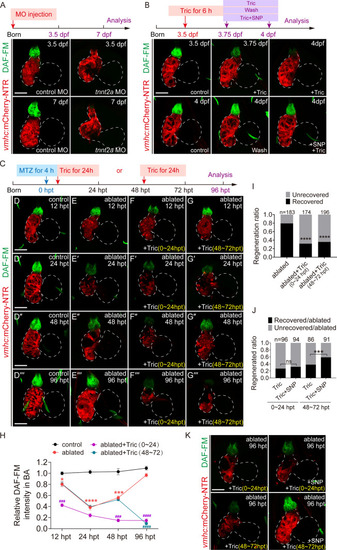
Reduced blood flow suppresses NO production in the BA. A, B DAF-FM DA staining of Tg(vmhc:mCherry-NTR) hearts showed that reduced blood flow via tnnt2a MO injection or tricaine treatment markedly suppressed NO production. SNP treatment could supply NO. C–G′′′ DAF-FM DA staining showed that tricaine treatment for 0–24 or 48–72 hpt significantly reduced NO level in ablated hearts at 96 hpt. H Quantification of relative DAF-FM DA intensity of BA in the control, ablated, ablated + Tric-treated (0–24 hpt) and ablated + Tric-treated (48–72 hpt) groups. N = 5 for each group. Mean + s.e.m. ANOVA analysis, *P < 0.05, ***P < 0.001, ****P < 0.0001 as compared with control group; ###P < 0.001, ####P < 0.0001 as compared with ablated group. I Quantification of the heart recovery rate in the ablated, ablated + Tric-treated (0–24 hpt) and ablated + Tric-treated (48–72 hpt) groups at 96 hpt. The numbers of larvae analyzed for each condition are indicated. Binomial test, ****P < 0.0001. J Quantification of the heart recovery rate in ablated groups at 96 hpt treated with tricaine for 0–24 or 48–72 hpt, with or without co-treatment of SNP. The numbers of larvae analyzed for each condition are indicated. Binomial test; ns, not significant; ***P < 0.001. K DAF-FM DA staining of ablated hearts at 96 hpt treated with tricaine for 0–24 or 48–72 hpt, with or without co-treatment of the NO donor SNP. Scale bars, 50 μm. Dashed lines outline the hearts. dpf days post fertilization, hpt hours post treatment, NO nitric oxide, MO morpholino, Tric tricaine, SNP sodium nitroprusside dihydrate
|

